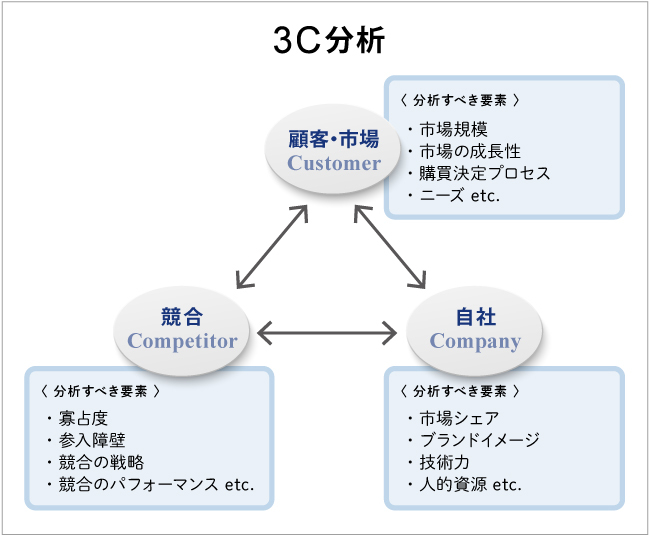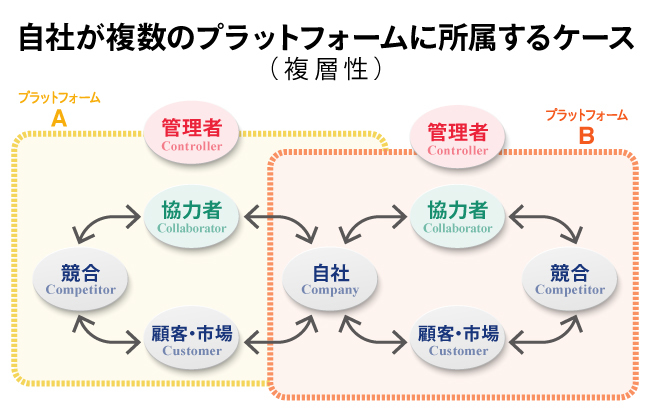Last time, I introduced the evolution of insights required for marketers in the digital age and the skills needed going forward. This time, I will introduce the environmental analysis framework I actually use in the initial steps of business development for digital services, primarily platform businesses, and solution product development.
The "3C" framework alone is insufficient for understanding platform businesses!
As many of you know, one of the well-known frameworks for environmental analysis is the "3C Analysis." This framework identifies a business's Key Success Factors (KSFs) and helps determine its strategy by analyzing the situations of the three main players: Customer (market/customer), Competitor (competition), and Company (the business itself).
Numerous books and resources explain the 3Cs in detail, so I'll skip the specifics here. It's an effective framework when the business model is simple and has few stakeholders.
However, when analyzing today's digitally-driven platform businesses, numerous players emerge that cannot be categorized under the 3Cs.
Simply put, a platform business generates revenue by providing a marketplace where both supply and demand sides transact.
For example, the iTunes Store and Kindle Store create spaces connecting music providers and publishers with users. Others, like Mercari and Coconala, facilitate transactions between individuals. Mobile carriers, which offer their own services while also incorporating third-party content, can also be broadly considered platform businesses. Specifically, the following types of players have emerged:
Content Providers: Players who offer content and services on the platform, thereby generating value for the platform
(Examples) Apps on the App Store, LINE stickers, YouTube videos
Service Providers: Players who provide the service itself that serves as the "space" for the distribution platform. That is, the platform operators.
(Examples) iTunes Store, Kindle Store, Yahoo! Shopping
Infrastructure providers: Players that provide foundational infrastructure such as operating systems and servers at the underlying layer of the platform
(Examples) Amazon Web Services, Android OS, iOS
Partner (Supporter): Players who provide advice and specialized business support to content providers
(Examples) Various agencies, certified consultants, C2C operational support services
When I was responsible for developing our company's platform service, I spent far more time than I imagined coordinating with players who control the "rules of the infrastructure layer," such as OS providers and server operators. There were many situations involving newly emerged players who weren't necessarily part of the traditional 3Cs.
Both content providers and service providers (platform operators) must accurately understand their market environment. This is because identifying the characteristics and trends of the infrastructure foundation— —directly impacts the entire service operation.
Expanding to "5C" by Adding Collaborator and Controller
There are numerous examples of frameworks adding new elements to the 3C model. You may have heard of approaches like adding the new players mentioned earlier to the "Market," or adding "Context or Climate" and "Collaborator," or adding "Customer's Customer" and "Customer's Competitor," or adding "Community" (regional or group affiliations).
To organize the participants and hierarchy involved in platform businesses, I have added the following two players to the framework, creating the "5C" model.
Collaborator: Participating businesses, partners, and other players
Controller: Service providers (platform operators) and players providing the platform infrastructure, such as the OS and servers
When visualized, the "5C" framework has the following structure:
"Collaborators" include not only content providers generating platform value but also players supporting content providers' activities. "Controllers" encompass service providers and infrastructure providers ( ).
Applying the "5C" framework to gain a comprehensive, multidimensional view of the business environment
Platform businesses, which are multi-layered and hierarchical, can be comprehensively and multidimensionally understood by applying the 5C framework.
Multi-layered structures occur when a company simultaneously belongs to multiple platforms within the same layer. For example, "developing and selling app services compatible with both iOS and Android operating systems." Another example is "selling the company's apparel products on both Distribution Platform A and Distribution Platform B."
Fierce competition also exists between platforms themselves. Therefore, new entrants must accurately assess market conditions and continuously analyze "which platform is most desirable for business development."
Applying the 5Cs, let's examine the smartphone market with LINE—Japan's largest communication app—at its core.

Competitors have been partially simplified for clarity.
Looking at this diagram from top to bottom, we see that LINE acts as the Controller for creators who want to sell stickers within LINE. Moving down the hierarchy, we observe that LINE builds numerous collaborative relationships with API partners while competing with other communication apps for users. At the lowest level, LINE is just one player providing its app on smartphone OS distribution platforms, adhering to the rules of major app stores.
※API (Application Programming Interface) is a mechanism that exposes software functionality, enabling other software to share those functions.
When analyzing platform businesses using the 5C framework, it is useful to consider the structure of the business environment ( ) surrounding the layer your company belongs to.
The key is to leverage the framework and keep thinking.
As a recap, in platform businesses, there exist players that do not fit into any of the 3Cs (own company, competitors, customers). It is crucial not to overlook the fact that these players play an important role in making the business viable. Therefore, it is necessary to use the 5C framework to identify the roles and relationships of each player.
The key points for correctly understanding the diverse players in platform businesses are the following two:
1.The existence of collaborators and administrators: Players who are neither competitors nor customers for your company.
2.Hierarchy: Players providing the platform mechanism itself also belong to some platform.
In business development and product development, misjudging market conditions can lead to failing to partner with the right entities, entering the wrong platform or tier, or being swayed by the platform operator's rules.
When considering entry into platform business, be sure to grasp the above points and conduct your own 5C analysis.
Finally, remember that frameworks are merely tools to accelerate problem-solving and decision-making by imposing constraints for analysis. Naturally, they have limitations, and no framework is perfect.
The previous article focused on skills, showing their evolution and changes. New business models will continue to emerge. The most crucial thing is not just to utilize frameworks, but to avoid becoming overly fixated on them and to keep thinking critically.
Next time, we'll introduce approaches to resource management for designing and operating businesses and services.







